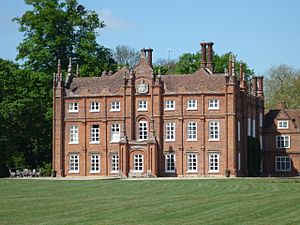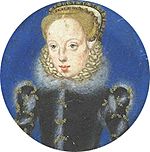Owen Hopton facts for kids
Sir Owen Hopton (born around 1519 – died 1595) was an important English landowner and government official during the time of Queen Elizabeth I. He was a Member of Parliament (MP), which means he helped make laws for the country. He is best known for being the Lieutenant of the Tower of London from about 1570 to 1590. This was a very important job, as he was in charge of the famous Tower of London and its prisoners.
Contents
Early Life and Career
Owen Hopton was the oldest son of Sir Arthur Hopton, who lived at Cockfield Hall in Yoxford, Suffolk. His mother was Anne, whose uncle was King Henry VII. This meant Owen had connections to the royal family.
When his father passed away in 1555, Owen inherited land, including the manor of Blythburgh. In 1559, he became a Member of Parliament (MP) for Suffolk. An MP is someone elected to represent an area in the country's government. In 1561, he was made a knight, which gave him the title "Sir." He also served as the Sheriff of Norfolk and Suffolk in 1564. A sheriff was a chief law enforcement officer in a county.
Caring for Lady Katherine Grey
Sir Owen Hopton was known for being kind to Lady Katherine Grey. She was a relative of the Queen and was held as a prisoner by Queen Elizabeth I. In October 1567, Lady Katherine was sent to stay at Cockfield Hall, Sir Owen's home, for the last few months of her life.
Lady Katherine had already been held in the Tower of London and then by other people. Sir Owen brought her to Yoxford and made sure she was comfortable. He wrote to Queen Elizabeth's chief advisor, Secretary Cecil, in January, saying that Lady Katherine was very ill. She was suffering from a serious lung illness and passed away on January 27, 1568.
Sir Owen was with her when she died. She gave him three rings to give to her husband and asked him to deliver a message to the Queen, asking for kindness towards her husband and children. Sir Owen promised to do this. The Queen asked Sir Owen to arrange a proper funeral for Lady Katherine at Yoxford church. The Queen's government paid for all the costs of her journey, stay, and funeral, which showed how much they trusted Sir Owen.
Lieutenant of the Tower of London
In 1571, Sir Owen Hopton was again a Member of Parliament for Suffolk. He became the Lieutenant of the Tower of London thanks to the support of William Cecil, who later became Lord Burghley. This was a very important job, and Sir Owen was paid £200 a year for it.
As Lieutenant, Sir Owen was in charge of many important prisoners. These included powerful people like the Duke of Norfolk. Sir Owen had to make sure the Duke was buried properly after he was executed. The Duke's grave was made in the church of St Peter ad Vincula within the Tower grounds.
Sir Owen also oversaw the questioning of prisoners and advised the Queen's Privy Council (a group of royal advisors). He was involved in the government's actions against Catholics at the time. For example, he was part of the questioning of Edmund Campion, a Catholic priest, in 1581. Sir Owen tried to get Campion to change his beliefs, but Campion remained strong. Sir Owen was also responsible for supervising certain procedures when prisoners were being questioned.
In 1582, he signed a directive from the Privy Council about public readings of a book called Anglorum Praelia. He also managed the Tower's armoury, which stored weapons and military equipment. In the 1580s, he had disagreements with the Mayor of London about who had authority over certain legal matters near the Tower. In 1588, he wrote a letter describing how well he had managed the Tower for over 18 years, including how he organized the Yeoman Warders, who are the ceremonial guards of the Tower.
Suffolk Community Leader
Sir Owen continued his political career, serving as a Member of Parliament for Middlesex in 1572 and 1584, and for Arundel in 1589. He also made arrangements for his lands to be passed on to his son, Arthur Hopton, who lived in Somerset.
People in the town of Walberswick remembered Sir Owen very fondly. Later, when another family tried to take away the rights of the local people to use common land, the older residents spoke up. They recalled how Sir Owen Hopton, who owned the land before the new family, was a "worthy gentleman" who "loved the poor town." They said he was much more generous and allowed them to use the land freely, unlike the new owners. This shows that Sir Owen was respected and liked by the people in his local community.
Death
Sir Owen Hopton passed away in 1595 and was buried in Stepney. His wife, Anne Hopton, died a few years later in 1599 and was buried in Oxfordshire, near Wroxton Abbey, which was the home of their daughter Anne.
Family
Sir Owen Hopton married Anne Echyngham. They had several children:
- (Sir) Arthur Hopton (died 1607), who lived in Blythburgh and Somerset. His son, also named Sir Arthur Hopton, became an ambassador to Spain.
- William Hopton, who was involved in a legal case with his brother Arthur in 1600.
- Ralph Hopton, who did not have children.
- George Hopton, who also did not have children.
- Anne Hopton, who married two times. Her first husband was Henry Wentworth, 3rd Baron Wentworth, and they had a son named Thomas Wentworth, 1st Earl of Cleveland. Her second husband was Sir William Pope, who became the Earl of Downe.
- Mary Hopton, who married William Brydges, 4th Baron Chandos.
- Cecilie Hopton, who married Sir George Marshall.



